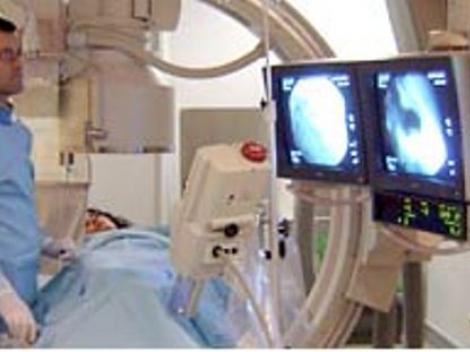


Specialized Centers
HOSPITAL CLÍNICA BENIDORM (HCB)
HOSPITAL INTERNACIONAL MEDIMAR
Cardiac Catheterisation and Coronary Angioplasty
Cardiac catheterisation is a diagnostic procedure that is performed to detect obstructions or narrowing (stenosis) of the coronary arteries. It consists of inserting a catheter into the arteries via a puncture.
Coronary angioplasty is a non-surgical treatment that dilates the narrowed coronary artery and restores normal blood flow to the heart muscle.
Benefits of the operation
Cardiac catherisation provides reliable information about heart function, the valves and coronary arteries to prevent causing chest angina, heart attack and even death.
Coronary angioplasty is used as an alternative to surgery (coronary bypass) or solely pharmacological treatment.
Medical-technical description
An incision is made in an artery, usually the radial or femoral artery, and a series of catheters are inserted with the aid of a special X-ray machine. Contrast material is injected through the catheter to allow the heart's chambers and major vessels and its functioning, contractility, flow, etc to be seen.
If coronary artery disease is diagnosed after the cardiac catherisation, sometimes one or several coronary angioplasties are performed. Balloon angioplasty involves inflating a small balloon fitted to the end of the catheter in the stenotic area to dilate the artery.
About the operation
Both cardiac catheterisation and coronary angioplasty take place in the cath lab, with the patient lying face upwards, conscious or lightly sedated. Local anaesthetic is applied in the catheter insertion site.
Catheterisation takes between 45 and 60 minutes, during which times your vital signs will be under constant observation. The catheter insertion points are usually in the groin (artery and femoral artery) and wrist (radial artery). The catheter is inserted through the selected artery to the heart, injecting contrast material which, by X-ray, allows the different structures of the heart to be seen and examined. Several catheters are used during the procedure. The movement of these catheters through the arteries is not painful.
Coronary angioplasty uses the same insertion site to insert a special catheter (catheter guide) as far as the origin of the coronary disease. A very fine wire (intracoronary guide) is inserted in the catheter and through the narrowed area. This guide is used to carry other catheters with a small balloon at the tip, which when inflated, expands the artery. Sometimes there is a stent around the balloon. When the balloon is inflated, the artery opens, restoring normal blood flow to the heart muscle. The stent is designed to stay open when the balloon is deflated and the catheter removed. Most modern stents are coated with drugs that delay the appearance of any further narrowed area inside.
Before the operation
- When you are admitted you will have a blood test, an electrocardiogram and your vital signs will be recorded.
- A line will be placed in a vein to administer medication if necessary.
- Your body hair will be shaved from the belly button to halfway down your thigh.
- Do not take oral anticoagulants (such as Sintron or Warfarin). Your cardiologist will tell you when to stop taking them and what medicines you should take instead.
- You can continue to take antiaggregants, such as aspirin, Adiro, Isocover and Plavix, as well as all the other drugs prescribed by your cardiologist.
- You will have to understand and sign the informed consent form before the operation. This will be given to you by your cardiologist.
- You must not eat or drink for five to six hours before your operation.
- Do not wear underwear or removable dentures. You must remove all metal objects (such as rings, bracelets, earrings, body piercings, etc.).
Post-operative care
- If you are having a coronary angioplasty, you will be admitted to the intensive care unit for at least 12 hours.
- The nursing staff in the unit will watch your vital signs and the catheter insertion site regularly according to the protocol established for this purpose.
- If the insertion zone is the femoral artery (groin), a small introducer may be left in the groin for four hours. It will then be removed and a compression bandage will be applied and then removed after 12 hours. You must rest in bed with the affected leg stretched out, for the entire time.
- Sometimes, the catheter insertion site in the femoral artery is sealed with an appliance. Even so, the patient must rest in bed with the affected leg stretched out, for 12 hours.
- If the insertion site is the radial artery (wrist), the compression bandage will stay on the wrist for between two and four hours.
- You can eat and drink after the procedure, provided there are no contraindications.
- Once the bleeding has stopped and the compression bandage has been removed, you will be able to sit and walk about.
- After you have been released you will be able to lead a normal life, although strenuous exercise and efforts are not recommended for the initial two days after release.
- When you are released you will be given a complete medical report and a CD with X-ray images of your procedure.



